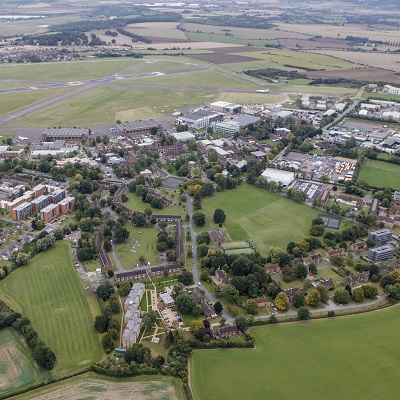Overview
- Start dateSeptember, February
- DurationTwo-three years part-time
- DeliveryTaught component 50%, Individual research project 40%, Course portfolio 10%. PgDip: Taught component 83%, Course portfolio 17%. PgCert: Taught component 100%
- QualificationMSc, PgDip, PgCert
- Study typePart-time
- CampusCranfield campus
Who is it for?
The Airworthiness Master's course is highly flexible and designed to meet the needs of individuals who are balancing work commitments with study. It is especially relevant to engineers and technologists working in the airworthiness field of aviation safety, either in a regulatory authority or in the industry. The format is especially suitable for those who wish to enhance and focus their knowledge in a structured but flexible, part-time format while continuing to work.
The subject of your research project can be chosen to match the research needs of your employer and/or your own career ambitions.
Why this course?
This course provides an academically recognised high standard of qualification related to the spectrum of technologies met in aerospace. It offers a wide range of technical knowledge in the context of related regulatory and safety issues, a background that managers in today's aerospace industry need to possess. A detailed knowledge of airworthiness issues early in the product development stage helps the downstream business operation which must balance cost and safety. This will also help to optimise the aircraft design, modification and/or the repair process.
Discover the range of facilities available to you as a student on the MSc in Airworthiness: My subject | Cranfield University Virtual Experience
We appreciate that students will be balancing employment with study which is why we aim to minimise the number of visits required to Cranfield University and offer modules in one-week blocks. Students undertaking the full MSc programme would be expected to come to Cranfield ten times in the 2-3 year period. We are well located for part-time students from across the world and offer a range of support services for off-site students.
We welcome delegates from all over the world and this provides a unique learning environment for both students and delegates who benefit from the mix of experience and backgrounds. Attendance of our short courses is a popular entry route onto this course as delegates are able to carry their credits forward onto the Airworthiness programme which a choice of qualification levels available to choose from:
- Master’s Degree (MSc) option of this course consists of a taught element (ten modules), an individual research project and course portfolio.
- Postgraduate Certificate (PgCert) option of this course consists of only the taught element where students must complete six modules.
- Postgraduate Diploma (PgDip) option of this course consists of a taught element (ten modules) and course portfolio.
Informed by Industry
The Airworthiness MSc is directed by an Industrial Advisory Board comprising senior representatives from industry. The board acts in an advisory role, assessing the content of the course and its relevance to present industrial needs. Current members include representatives from:
- Airbus
- Rolls-Royce
- Civil Aviation Authority (CAA).
Course details
There are seven mandatory modules which aim to provide you with a common basis of knowledge and skills on which the specialist options can build further. You are then free to choose three optional modules in line with your developing interests.
The course uses a range of assessment types. Students can expect to have written examinations, assignments and presentations as well as the group design and individual research projects. The range of assessment methods have been chosen to develop skills and be of relevance to the taught materials.
Course delivery
Taught component 50%, Individual research project 40%, Course portfolio 10%. PgDip: Taught component 83%, Course portfolio 17%. PgCert: Taught component 100%
Individual project
The individual research project is completed by students who wish to complete the MSc qualification of the Airworthiness course. The project is normally undertaken in the final year and brings together the learning from the taught components to consolidate learning. The subject of the project is normally chosen to reflect the needs of the sponsoring organisation and/or to match your career ambitions. Project topics represent the broad range of areas covered by the course.
Previous Individual Research Projects have included:
- An assessment of the applicability of an ageing aircraft audit to the microlight aircraft type
- The justification of ALARP by Ministry of Defence aircraft project team
- Introduction of a service bulletin review process in the military environment.
Modules
Keeping our courses up-to-date and current requires constant innovation and change. The modules we offer reflect the needs of business and industry and the research interests of our staff and, as a result, may change or be withdrawn due to research developments, legislation changes or for a variety of other reasons. Changes may also be designed to improve the student learning experience or to respond to feedback from students, external examiners, accreditation bodies and industrial advisory panels.
To give you a taster, we have listed the compulsory and elective (where applicable) modules which are currently affiliated with this course. All modules are indicative only, and may be subject to change for your year of entry.
Course modules
Compulsory modules
All the modules in the following list need to be taken as part of this course.
Airworthiness Fundamentals
| Aim |
|
|---|---|
| Syllabus |
• Air Law • Certification Process, including the safety assessment of aircraft systems • Airworthiness Lessons learned - Review of significant accidents • Production Organisation Approval (POA) • Maintenance and Operations Approvals • Continuing Airworthiness management • Engine certification • Application of Safety Management Systems in the field of airworthiness • Human Factors in maintenance • Incident reporting • Engine failure modes • FAA certification of non-US products • Current airworthiness challenges. |
| Intended learning outcomes |
On successful completion of this module a student should be able to: 1. Describe the legal basis which underpins airworthiness regulation in aircraft design, production, operation and maintenance. 2. Interpret the principles of airworthiness as applied to the process of aircraft and engine certification 3. Communicate the importance of airworthiness requirements as they relate to aircraft design, production, operation and maintenance. 4. Articulate the process for Continuing Airworthiness management for different types and sizes of operator. |
Aircraft Fatigue and Damage Tolerance
| Aim |
|
|---|---|
| Syllabus |
|
| Intended learning outcomes |
On successful completion of this module a student should be able to:
|
Safety Assessment of Aircraft Systems
| Aim |
To familiarise course members with the various approaches to the problems of assessing the safety of increasingly complex aircraft systems. |
|---|---|
| Syllabus |
Outline of relevant accidents and system design philosophy. Discussion of acceptable accident rates and recent advances in systems. Introduction to probability methods. Regulatory background The development of requirements for safety assessment, FAR / EASA CS25—1309. Methods and techniques Introduction to the more common safety analysis techniques. Influence of human factors. Common mode failures, traps and pitfalls of using safety assessment and examples of mechanical systems and power plants. Use of safety assessment techniques Determination of correct architecture of safety critical systems. Fault Tree Analysis, Dependence Diagrams and Boolean algebra for quantification of system reliability. Zonal safety analysis (ZSA), Particular Risk Analysis (PRA) and Failure Mode and Effect Analysis (FMEA) of aircraft systems. Practical examples of the application of safety assessment techniques Minimum Equipment Lists (MEL), Safety and Certification of digital systems and safety critical software. Application of Aerospace Recommended Practice (ARP) 4761. Typical safety assessment for a stall warning and identification system. Current and future issues Integrated and modular systems and their certification. Certification maintenance requirements. Flight-deck ergonomics. |
| Intended learning outcomes |
On successful completion of this module you should be able to:
|
Gas Turbine Fundamentals
| Aim |
To provide an opportunity to acquire a good general understanding of the principles of gas turbine design and performance appropriate to both manufacturing and user industries |
|---|---|
| Syllabus |
• Gas turbine fundamentals |
| Intended learning outcomes |
On successful completion of this module a student should be able to:
|
Air Transport Engineering - Maintenance Operations
| Aim |
|
|---|---|
| Syllabus |
• Optimisation of maintenance - Outsourcing/In House Maintenance; Application of Lean principles to Maintenance operations; Maintenance planning; Maintenance costs. • Human Factors in Aircraft Maintenance - Error types; Classification systems; Maintenance Error Management System; Maintenance Error Decision Aid (MEDA) & other resources. • Logistics and supply chain management. • Linkages between manufacturer, operator and maintenance organisation. • Continuing airworthiness management and Regulatory aspects (EASA Part M). • Health and usage monitoring, engine condition monitoring etc. |
| Intended learning outcomes |
On successful completion of this module you will be able to: 1. Describe the principles of reliability with direct relation to aircraft availability. 2. Outline a maintenance management programme, including the interface with operations, supply chain and cost issues. 3. Critically appraise the various aircraft maintenance philosophies used for in-service aircraft. 4. Develop a process for achieving continuing airworthiness management with the appropriate regulatory approval. |
Aviation Safety Management
| Aim |
To provide students with the fundamental knowledge and skills required to manage operational safety within the aviation industry. |
|---|---|
| Syllabus |
|
| Intended learning outcomes |
On successful completion of this module you will be able to:
|
Design of Airframe Systems
| Aim |
|
|---|---|
| Syllabus |
|
| Intended learning outcomes |
On successful completion of this module you should be able to: 1. Identify the main airframe systems and explain their purposes and principles of operation; including Secondary Power Systems (Pneumatic, Hydraulic and Electric), Environmental Control Systems, Ice Protection Systems, Flight Control Power Systems and Fuel Systems. 2. Formulate the requirements that drive the design of the main airframe systems. 3. For each of the main airframe systems: differentiate the various architectures and reasons behind the differences; identify types of equipment and major components used and assess their principles of operation; and perform basic sizing analysis for systems and major components. 4. Appraise the effects of airframe systems power provision on aircraft power plants and analyse fuel penalties resulting from a given system’s presence on an aircraft by carrying out basic calculations. 5. Examine the reasons for, and propose possible types of changes, that may occur in airframe systems in the near future. |
Airworthiness Dossier
| Aim |
Another purpose of the module is for the student to demonstrate their understanding of the relationships between the technology and the regulations. |
|---|---|
| Syllabus |
On successful completion of this module a student should be able to: |
| Intended learning outcomes |
The dossier is to provide a summary of the whole course (the nine modules that a student attends) with a focus on airworthiness and technology issues. |
Individual Research Project - MSc only
| Aim |
|
|---|---|
| Syllabus |
The subject of the thesis is agreed between the student and the supervisor and will normally be based around part of the taught material and/or a company problem. |
| Intended learning outcomes |
On successful completion of this module a student should be able to:
|
Elective modules
One of the modules from the following list need to be taken as part of this course
Mechanical Integrity of Gas Turbines
| Aim |
To familiarise course members with the common problems associated with the mechanical design and lifting of the gas turbine engine and its components |
|---|---|
| Syllabus |
Loads / forces / stresses in gas turbine engines |
| Intended learning outcomes |
On successful completion of this module a student should be able to: |
Practical Reliability
| Aim |
To familiarise course members with the reliability analysis of data from tests and service records, and methods of evaluating system reliability as part of design. |
|---|---|
| Syllabus |
|
| Intended learning outcomes |
On successful completion of this module a student should be able to:
|
Aircraft Accident Investigation and Response
| Aim |
This course is based around a case study approach to aircraft accident investigation. You will have the opportunity to experience important elements of aircraft accident investigation from initial notification of an event through to generating and communicating investigative findings. |
|---|---|
| Syllabus |
|
| Intended learning outcomes |
On successful completion of this module you should be able to:
|
Fundamentals of Aircraft Engine Control
| Aim |
|
|---|---|
| Syllabus |
Compressor performance |
| Intended learning outcomes |
On successful completion of this module a student should be able to:
|
Manufacturing
| Aim |
This module provides you with a general understanding of a range of issues associated with aircraft manufacturing. The module covers mostly technical, but with some management topics related to manufacturing processes and technologies. Topics include material and manufacturing process selection, modern manufacturing technologies such as 3D printing and composite manufacture. |
|---|---|
| Syllabus |
• Manufacturing systems. • Materials and manufacturing process selection. • Joining technologies. • Composite manufacture. • Automation technologies. • Lifecycle analysis in manufacturing. • Manufacturing cost engineering. • Quality engineering. |
| Intended learning outcomes |
On successful completion of this module you should be able to: |
Flight Experimental Methods (Airworthiness)
| Aim |
The aim of this module is to provide an introduction to the performance, stability and control characteristics of a conventional aircraft. |
|---|---|
| Syllabus |
• Cruise performance - Specific Air Range and Specific Endurance. • Static equilibrium and trim. • Longitudinal static stability, trim, pitching moment equation, static margins. • Manoeuvrability: steady pull-up manoeuvre, pitching moment in manoeuvre, longitudinal manoeuvre stability and manoeuvre margins. • Lateral-directional trim and static stability |
| Intended learning outcomes |
On successful completion of this module a student should be able to: • describe the concepts of equilibrium, trim, static, manoeuvre and dynamic stability; • evaluate the cruise performance and the aerodynamic and stability characteristics of a conventional aircraft; • apply the principles of flight test analysis and assessment; • compile and present a technical report in written form; • work effectively in a group environment. |
Design, Durability and Integrity of Composite Aircraft Structures
| Aim |
The course seeks to provide engineers with knowledge of polymer composite properties and behaviour relevant to their in-service performance durability and maintenance in aircraft structures |
|---|---|
| Syllabus |
Basic principles |
| Intended learning outcomes |
On successful completion of this module you should be able to:
|
Introduction to Avionics
| Aim |
To provide a comprehensive overview of avionics systems and infrastructures. |
|---|---|
| Syllabus |
• Historical overview of the development of avionics hardware. • The evolution of the cockpit. • Modern Human-machine interface and interaction. • Automation – evolution, the modern fly-by-wire autopilot and the flight management system. • Display technologies – HDD, HUD, HMD. • Airborne sensor systems. • Fundamentals of radio communication. • Navigation and communications systems – terrestrial and satellite-based systems, autonomous navigation systems, digital data links. • Radar – principle of operation, operational modes, radar cross section. • Avionics databases – fundamental architectures; ARINC 429, 629, 664; MIL-1553. • Traffic and terrain surveillance and situational awareness systems – transponder, TCAS and EGPWS. • Principles of air traffic management. • Military applications – electronic warfare and countermeasures. • Product design considerations – design standards, fault tolerance and product life cycle. • Case study – a complete avionics installation. This module has an additional tutorial inside the cockpit of the large aircraft flight simulator. Students will be able to appreciate the cockpit layout design, understand information displayed to the pilot, and have the opportunity of flying the simulator. This tutorial is intended to enhance the learning process and the knowledge gained. |
| Intended learning outcomes |
On successful completion of this module you should be able to:
|
Introduction to Aircraft Structural Crashworthiness
| Aim |
|
|---|---|
| Syllabus |
- Objectives and Approach
- Regulations - Human Tolerance
• Crash Energy Management
• Structural Collapse - Collapse of metallic and composite structural components - Component collapse vs. structural collapse • Introduction to methods for crash analysis - Hand calculations - Hybrid analysis methods - Detailed analysis methods
• Role and capability of testing and simulation in the crashworthiness field
|
| Intended learning outcomes |
On successful completion of this module you should be able to:
|
Human Factors in Aviation Maintenance
| Aim |
|
|---|---|
| Syllabus |
|
| Intended learning outcomes |
On successful completion of this module you should be able to:
|
Teaching team
The course director for this programme is Dr Joni Pelham.
Accreditation
The Airworthiness MSc is accredited by:
- The Institution of Mechanical Engineers (IMechE)
- Royal Aeronautical Society (RAeS)
on behalf of the Engineering Council as meeting the requirements for further learning for registration as a Chartered Engineer (CEng). Candidates must hold a CEng accredited BEng/BSc (Hons) undergraduate first degree to show that they have satisfied the educational base for CEng registration. Please note accreditation applies to the MSc award. PgDip and PgCert (if offered) do not meet in full the further learning requirements for registration as a Chartered Engineer.
Your career
Many of our students are already in employment with aerospace/defence companies and choose to pursue an internationally recognised qualification with Cranfield University to enhance their career. Graduates are able to use this qualification to obtain secure permanent positions abroad.
Destinations of our students vary as many remain with their sponsoring company, often being promoted upon completion of the course. Some companies have used the Airworthiness programme as pre-employment training.
Cranfield’s Career Service is dedicated to helping you meet your career aspirations. You will have access to career coaching and advice, CV development, interview practice, access to hundreds of available jobs via our Symplicity platform and opportunities to meet recruiting employers at our careers fairs. Our strong reputation and links with potential employers provide you with outstanding opportunities to secure interesting jobs and develop successful careers. Support continues after graduation and as a Cranfield alumnus, you have free life-long access to a range of career resources to help you continue your education and enhance your career.
How to apply
Click on the ‘Apply now’ button below to start your online application.
See our Application guide for information on our application process and entry requirements.












